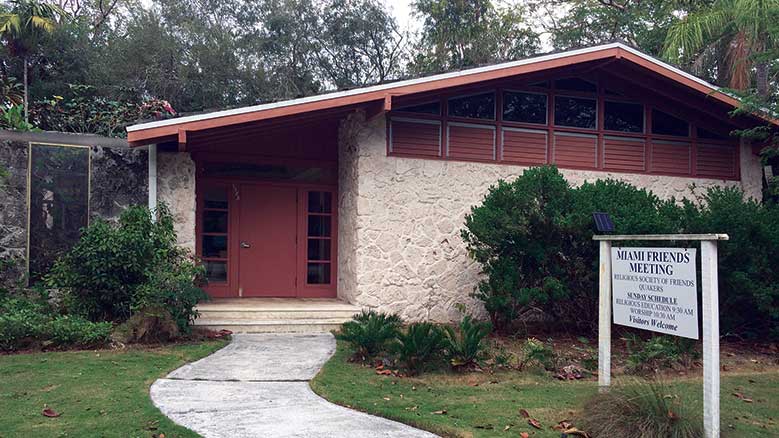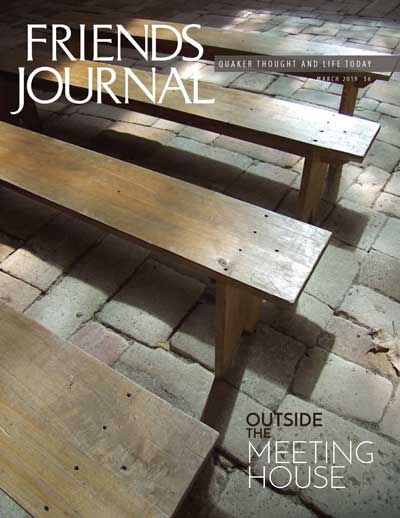
When you are the clerk of the Buildings and Grounds Committee at your Friends meeting, the words “outside the meetinghouse” have particular meaning. For this clerk, wondering what your building and grounds are saying to the world outside is both thought-provoking and actionable. Our Buildings and Grounds Committee members deal with the outside often as they contend with what the meeting is doing or neglecting.
Most Friends have an understanding of the architectural message that our meetinghouses express. We understand the simplicity of the structure. We understand the reason there are no steeples or crosses on the outside and why we have clear windows placed so as to invite the light to enter. We are equally sensitive to interior design. While we come into frequent, intimate contact with the meetinghouse exterior, and the land it sits on, we may be less aware of the message they convey.
Friends property is a prominent, public statement of our values and beliefs. Our land, our buildings, and our landscape all convey what educators call a hidden curriculum: messages and lessons that are not overtly stated but are inherent or implied. Friends need to understand our hidden messages, as these are the messages that our neighbors, passersby, our municipality, and our community groups receive every time they are in contact with our property. From a street, road, lane, or path, our properties are visible night and day, day after day. Even when a property is devoid of humans, it continues to act as a witness for us. We must ask ourselves what messages we mean to convey, and be mindful of our intentions in implementing them.
The Buildings and Grounds Committee of Miami (Fla.) Meeting asked Friends to try a thought exercise. The next time they came to the meetinghouse, they were to imagine seeing it for the first time. They were encouraged to pretend to stumble on the building and to pay attention to their internal discovery process. They were asked to notice their immediate reaction to the entrance; to the parking; to the trees, bushes, and flowers; and even to the insects. They should note their feeling and sense about the place. They were asked to notice as they walk down the path and up the steps to the door: how were they feeling? Were they feeling welcomed, sensing an invitation to Spirit?
We posted a number of questions on our website for Friends to consider, among them:
- What are the messages we wish to present to people who approach the meetinghouse?
- Are the physical aspects of the meeting welcoming, inviting, and accessible?
- Do the grounds and buildings create spiritual space and invite Spirit and Light?
- What does the manner in which we maintain the grounds and buildings say about us as a spiritual community, as global citizens, as neighbors?
- While honoring simplicity, are we still honoring beauty and Spirit?
- What messages are we giving about our relationship to earth and our care of earth?
Our small enlightenments have not come by serendipity but rather by queries. Through our questioning and openness, we discovered where we are in alignment with our values and where alignment is needed.
Wrestling with these questions has led us to new insight into what we are expressing through our buildings and our landscape. The meeting has become aware of a number of intentional and positive messages we express through the buildings and grounds, and we have discovered those places where what we say and do outside the meetinghouse is not congruent with our values. The exercise led us to work to bring our outward, public presence more in line with our spiritual values.
For example, we hold care of the natural world as a value and we exemplify this in many ways. We support our yearly meeting’s field secretary for earthcare and Quaker Earthcare Witness, so our outside should reflect this same concern. One way has been to gradually replace exotic plants with native plants that reflect a respect for place and are much easier on resources. Native plants require far less human intervention and far less water. By our plant choices, we become an example of good stewardship for the neighborhood and for those who visit the meetinghouse.
We have worked with our municipality, the city of Coral Gables, and with our neighbors to turn the once muddy, weedy swales between the sidewalks and the streets into lovely beds of ferns. After soliciting the support of our neighbors, the city graciously planted ferns and mulched around them. Not only has the mud disappeared, but also the city was happy to remove the no parking signs, as the plants are a natural deterrent to parking. In this way, we are demonstrating community, cooperation, and good citizenship.
We have realized that the entrance to our property and the parking areas have been in need of attention. They are not inviting, not fully functional, not fitting in with the surrounding residents’ property, and not reflective of our values. We are in the process of redoing the entrance and parking areas with attention to access, attractiveness, simple functionality, and care for earth. When completed, we will evidence better, more Friendly messages from the moment people arrive.
Our last work day, we began renovation of a butterfly garden at the front of the meetinghouse that we had established with a Quaker Earthcare Witness mini-grant but had neglected. Not only had it become an eyesore, but it had ceased to attract pollinators. Without the pollinators, it is unattractive to the passing children on their way to the school across the street. The message to the kids and their parents that we had intended had lost its value.
We have seen that our picnic table is sad and needing paint and that the flowers and plants around it could use attention. It is a table that the crossing guards and other staff from the school use. It should be welcoming and inviting, and better express our open invitation to worship inside.
We have learned that by being mindful and intentional, both our hidden and overt messages have a better chance of becoming integrated expressions of our values inside and outside the meetinghouse.
Sometimes we take architectural and landscaping messages for granted, and we can become accustomed to slow diminishment. Our small enlightenments have not come by serendipity but rather by queries. Through our questioning and openness, we discovered where we are in alignment with our values and where alignment is needed. As Friends know, this should not be a one-time event but rather part of continuing work. Insight needs a consciously created context that invites discovery. We have learned that by being mindful and intentional, both our hidden and overt messages have a better chance of becoming integrated expressions of our values inside and outside the meetinghouse.






Some UK meeting houses give very odd impressions. For example, Bull Street (Birmingham) and Friends House (London) look more like Masonic temples than simple Quaker buildings.
Our grounds, whether they be in an urban or riral context, can prepare us to slow down and smell the proverbial roses as we enter our sacred meetinghouses, already humbled in gratitude.